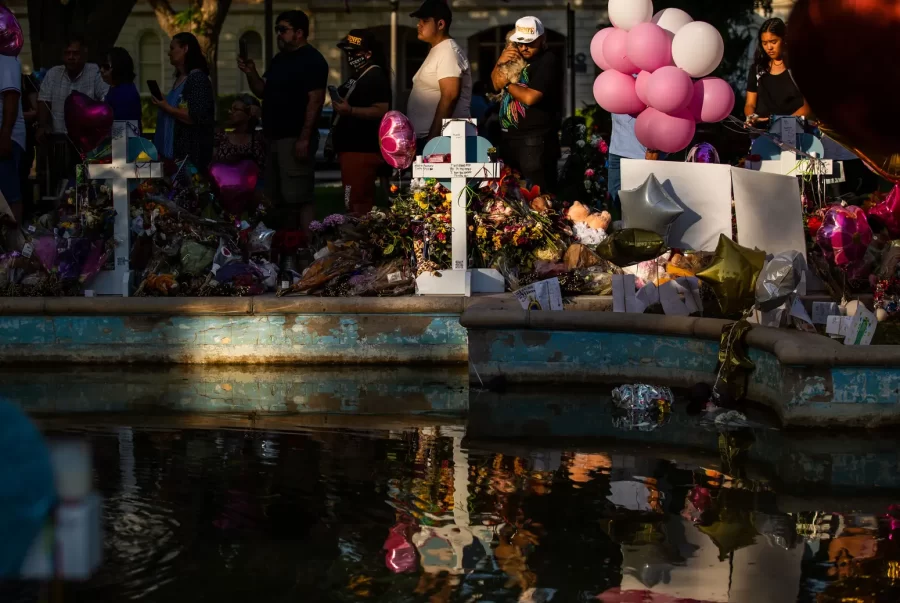New Texas mental health youth program fails to reach Uvalde before shooting
Texas was building a program to find troubled students and prevent school shootings but it hadn’t reached Uvalde yet.
KAYLEE GREENLEE BEAL/The Texas Tribune
Thousands of roses and handwritten notes, hundreds of candles and dozens of stuffed animals surround a fountain in the center of Uvalde’s Town Square on May 29, 2022.
June 2, 2022
UVALDE, Texas — By most accounts, the Uvalde school gunman was the type of person a $290 million Texas youth mental health program was designed to reach — before his apparent instability could escalate to mass violence.
But it hadn’t reached Salvador Ramos when the 18-year-old high school dropout — whose adolescent years were reportedly beset by truancy, cruelty to animals and violence at home and at school — walked into Robb Elementary with an assault rifle and killed 19 kids and two teachers, health officials said.
Created by state lawmakers in 2019 and already present in 300 school districts comprising some 40% of the state’s school population, the Texas Child Mental Health Care Consortium of experts has treated more than 6,000 students identified by school staff and doctors — including those at high risk for hurting themselves or others.
Ramos’ school district was on the list to be offered entry into the program, but has not been formally included yet because the program is still ramping up, said Dr. Steven R. Pliszka, chair of psychiatry and behavioral sciences at UT Health San Antonio and administrator of the university’s consortium-funded program.
“We kind of reached a limit to our staffing in the first round of funding and we were planning to reach out to more rural districts, and Uvalde was obviously on our list,” he said. “Sadly, this happened before we could make that connection.”
The teen gunman, many in the mental health community say, might have been identified early and perhaps even diverted from that devastating path had more resources been available to him and those around him as he grew up in an underserved area.
“I think the work the consortium does is part of the answer, but it isn’t necessarily the whole answer,” said Dr. David Lakey, head of the Texas Child Mental Health Care Consortium and vice chancellor for health affairs at the University of Texas System.
Abbott, a pro-gun Republican who pushed for the creation of the consortium after the deadly 2018 mass shootings in El Paso and Odessa, insisted in the hours after the Uvalde massacre that the problem was rooted in the lack of mental health services in that rural area, not lax Texas gun laws.
The governor’s comments after the Uvalde shooting mirrored those made after the last mass shooting: The problem is mental illness, not guns.
That certainly was at least part of the reasoning behind the state’s creation of the child mental health consortium, which first appeared in 2018 in a School Safety Action Plan pushed by Abbott to avoid more mass shootings, particularly in schools — in a section called “Preventing Threats in Advance.”
A day after the shootings, Abbott said authorities were unaware of any criminal or mental illness history of 18-year-old Ramos that could have identified him as a potential threat.
But he also said mental illness was described by the sheriff and other local officials as “the problem here.”
According to media interviews with Ramos’ friends, family and others who knew him, the teenager was about to be denied graduation from his high school in Uvalde because of excessive truancy.
In both middle school and high school, he was characterized as a bully who had at one point been teased about a stutter and a lisp. Social media posts he made were threatening and by classmates’ accounts, he had a hard time making and keeping friends.
His father didn’t have a lot of contact with him and his mother, who has been characterized by family members as a drug user. The house the teen once shared with her was visited by police several times during arguments between the two, with Ramos accusing his mother of trying to kick him out.
But when it comes to services for Uvalde’s troubled youth and mentally ill, there is little debate about how much access they have there.
“It’s a fairly underserved area,” Pliszka said.
Because the shooting both highlighted the more urgent need for services there and likely created the need for them for those left behind, Uvalde schools are now being offered access to those services immediately, Pliszka said.



